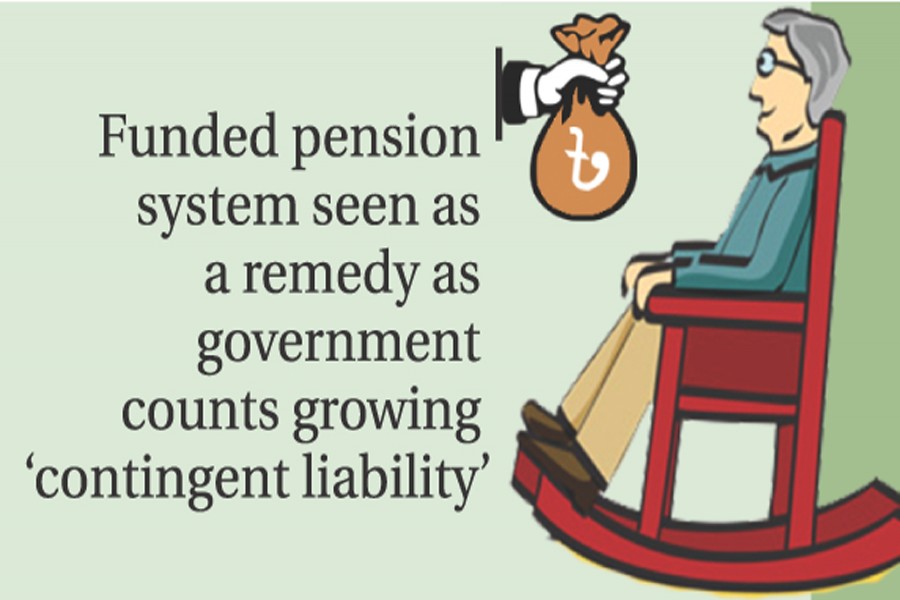Pension payments have more than doubled in two years following a recast of retirement-benefit reckonings, making public exchequer bear higher "contingent liability".
As such, some noted economists think that a "funded pension" system could be beneficial to both government and its employees.
People familiar with the matter told the FE that the ageing population and an increase in the number of pensioners will continue to create a greater burden for the government.
The economists noted that the existing method of pension -- 'pay as you go financing' -- if gets converted into a fully-funded one the risk relating to future financing would be largely minimised.
The government paid over Tk 146.67 billion, equivalent to more than 8.0 per cent of the revenue budget, in the last financial year (FY) to June 30 last on account of pension. And this was 0.75 per cent of the GDP in the last FY, 2016-17.
The government payments for pension in the financial year 2016 amounted to Tk 102.84 billion. But it was only Tk 71.29 billion in the financial year 2015.
Senior people at the Controller General of Accounts told the FE there were some reforms in terms of enhancing government employees' benefits, pushing up the amount to one of the highest in revenue expenditures.
They also said the number of retirees had increased in the last couple of years as job tenures of many got extended for a raise in government- service length by two years to 59 on grounds of longer life-expectancy.
Dr Zahid Hussain, lead economist at the Dhaka office of the World Bank, said this is definitely a contingent liability for the government as ultimately the government needs to bear it.
"This is non-discretionary revenue expenditure. And the government is committed here to paying [to the pensioners]," Dr Hussain told the FE.
This is increasing the burden, which suggests that the government should conduct another reform converting the existing pension system to a fully-funded one.
"If there is funded system of pension, then the future earnings and benefits could be estimated," he said.
Many governments, including that of the United States of America, use trust funds in their pension programmes. Such funds are best thought as accounting exercises. This type of calculation enables policymakers to know whether their pension system has long-term unfunded liabilities.
Dr Hussain said funded pension system is solvent over the long term as huge earnings are received from investment of such funded pension.
Dr Ahsan H Mansur, executive director of Policy Research Institute of Bangladesh (PRI), also has expressed identical views saying that there is need for a funded pension system to get rid of huge fiscal burden.
He said a contribution-based pension system should be introduced immediately to ease government's burden.
With pension payments rising and Bangladeshis living longer, there should be a system of pension from where the employees would be eligible to draw pension after reaching a certain age, even before retirement.
He said the government might contribute 10 per cent to the fund alongside the employees' contributions. The fund might be deposited with a board of trustees.
However, the government relaxed eligibility criterion to five years to 25 years. Earlier, it was ten to 25 years of services in government jobs.
Pension is granted to a government servant on his/her retirement from public service on the basis of length of qualifying service rendered and amount of emoluments last drawn.
The rate of pension has now been extended to 90 per cent from the previous 80 per cent, according to CAG's latest documents.
The LPR (Leave Preparatory to Retirement) has now been extended to 18 months from the previous duration of 12 months.
The government has made mandatory 50 per cent at one go calculated on the employee's last drawn basic at a rate of 90 per cent. The public servant now must take 50 per cent of the 90 per cent as benefit.
Pension takes the form of provision of annuities for the aged. Historically, old-age pensions was guaranteed by a government to its employees in France in the 19th century, followed by its introduction in the UK in 1834 and in Germany in 1873.
The system of pension eventually spread over to many countries of Europe and North America in the first decade of the 20th century. In the region constituting Bangladesh, pension for older population was first introduced in 1924, primarily for government employees.
Bangladesh government modified the pension rules for the first time in 1972. Based on that pension was provided by fixing pay on average of last 12 months' salaries instead of average pay of last 36 months as was the system before.
In 1974 pension was paid on the basis of a certain per cent of last pay drawn instead of 12 months' average pay. The maximum pension amount was 60 per cent of the last pay.
In 1977, by way of modification with respect to family pension and gratuity, new pension rules were announced, and according to these rules, the maximum pension amount was fixed at 80 per cent of the basic pay drawn.
Lastly in 1994, the government simplified the rules and regulations relating to the sanctioning of pensions. And the latest reforms were made in the last couple of years.


